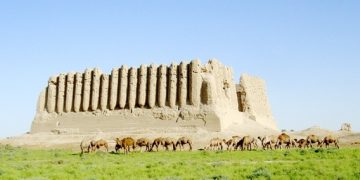
Merv was a capital of the Seljuk empire that extended from central Asia to the Mediterranean. According to some estimates, Merv was one of the biggest city in the world in 1200’s, with a population of more than half a million people.
A trader arriving from Bukhara to the north-east or from Nishapur to the south-west would once have been relieved at the sight of Merv. Crisscrossed by canals and bridges, full of gardens and orchards, medieval Merv and its surrounding oasis were green and richly cultivated, a welcome reprieve from the bleakness of the Karakum desert. The city’s enclosing walls ran in an oblong circuit of five miles, interrupted by strong towers and four main gates. Its streets were mostly narrow and winding, crowded with closely built houses and occasional larger structures: mosques, schools, libraries and bathhouses. The stronghold of the Seljuk sultans – replete with a palace, gardens and administrative buildings – loomed over the north-eastern part of Merv. Many different polities chose to make Merv the seat from which to rule Khorasan, a region that included eastern Iran and parts of modern-day Turkmenistan, Uzbekistan, Tajikistan and Afghanistan.
“For its cleanliness, its good streets, the divisions of its buildings and quarters among the rivers … their city Merv is superior to the rest of the cities of Khorasan,” wrote the 10th century Persian geographer and traveler al-Istakhri. “Its markets are good.”
Reaching Merv, the visiting trader might lead his pack-animals into the open courtyard of a two-story caravanserai (an inn with a courtyard for travelers), where he would jostle for space with other merchants from as far as India, Iraq and western China. Or he could go straight to one of Merv’s large markets, convened outside the gates of the town or sometimes near its major mosques. The smoke of potters’ kilns and steel-making furnaces (Merv was famous for its crucible steel) would have hung over the surrounding industrial suburbs.
If the trader was feeling hot, he might step inside the icehouse on the city outskirts; a tall conical building where residents accumulated snow during the winter and which they used like a vast mud-brick fridge. Maybe he paid a visit to a member of the city’s elite who lived in a koshk (a fortress-like home outside the walls removed from the dust and noise of the city).
If he followed the route of the Majan canal, which ran up the middle of the city, past the workshops of embroiderers and weavers, he would reach both Merv’s central mosque and the adjacent monument, the mausoleum of Sultan Sanjar. Built in 1157 AD to honor the long-ruling Seljuk sultan, the mausoleum was a large, square-shaped building rung with fine arches, capped by a dome sheathed in turquoise-glazed tile. The dome was so intensely blue that according to the Arab geographer Yaqut al-Hamawi, who visited Merv in the 13th century, “It could be seen from a day’s journey away.”
The city was known as Marwu-Shahu-jahan or “Merv the Great”, the largest and most famous of a succession of towns in the Merv oasis. In fact, the city sat alongside an earlier incarnation of Merv just to the east, known as Gyaur-kala (“fortress of the pagans”).
Gyaur-kala flourished under the Sassanid kings of Persia from the third to the seventh centuries AD. Archaeologists have found evidence in this older Merv of a cosmopolitan urban society, boasting communities of Zoroastrians, Buddhists, Manicheans, Christians and Jews. Under Muslim rule from the seventh century onwards, the locus of urban activity shifted west across the Razik canal to what would become Marwu-Shahu-jahan (also known as Sultan-kala, “fortress of the sultan”). Many of Gyaur-kala’s structures were probably cannibalized for material in the construction of the new Merv, and industrial workshops, kilns and furnaces sprung up amid its ruins.
The second source of Merv’s prosperity and growth was its strategic location perched on the crossroads of transcontinental trade. Merv was famous for its exports, especially its textiles. “From this country is derived much silk as well as cotton of a superior quality under the name of Merv cotton, which is extremely soft,” noted the 12th-century Arab geographer Al-Idrisi. Robes and turbans made from Merv cloth were popular around the Islamic world.
So too were Merv’s much-loved melons. “The fruits of Merv are finer than those of any other place,” wrote Ibn Hawqal, a 10th century Arab chronicler, “and in no other city are to be seen such palaces and groves, and gardens and streams.”
Merv had such a strong reputation for commerce and the pursuit of wealth that the 14th century Egyptian scribe al-Nuwayri described the city’s chief characteristic as “miserliness”.
But Merv under the Seljuk’s was also a city of learning and culture. It produced notable poets, mathematicians, astronomers, physicians, musicians and physicists. The polymath Omar Khayyam is known to have spent several years working at the astronomical observatory in Merv. “Of all the countries of Iran,” al-Istakhri wrote of Merv, “these people were noted for their talents and education.” Yaqut al-Hamawi counted at least 10 significant libraries in the city, including one attached to a major mosque that contained 12,000 volumes.
n its Seljuk heyday, Merv was a cultural capital, attracting the brightest thinkers and artists from around the Islamic world. It set trends not only in scientific and astronomical investigation, but in architecture, fashion and music. To be marwazi (from Merv) suggested a degree of cultivation and sophistication. Its residents probably possessed a very broad frame of reference. Though secluded in an oasis in the Karakum desert, Merv was a worldly city, an exemplar of the commercial and intellectual culture that flourished along the Silk Road.
Merv was also no stranger to political upheaval and war, having fallen under the sway of competing polities and dynasties throughout its long history. No conquest was as traumatic as its pillage by the Mongols in 1221. Yaqut al-Hamawi was forced to flee the libraries of Merv as the armies of Genghis Khan’s son Tolui advanced upon the city.
“Verily, but for the Mongols I would have stayed and lived and died there, and hardly could I tear myself away,” he wrote sadly. The Mongols laid siege for six days before the city surrendered, prompting one of the worst massacres of the age.
According to the Arab historian Ibn al-Athir, who based his account on the reports of refugees from Merv: “Genghis Khan sat on a golden throne and ordered the troops who had been seized should be brought before him. When they were in front of him, they were executed and the people looked on and wept. When it came to the common people, they separated men, women, children and possessions. It was a memorable day for shrieking and weeping and wailing. They took the wealthy people and beat them and tortured them with all sorts of cruelties in the search for wealth … Then they set fire to the city and burned the tomb of Sultan Sanjar and dug up his grave looking for money. They said, ‘These people have resisted us’ so they killed them all. Then Genghis Khan ordered that the dead should be counted and there were around 700,000 corpses. “The Mongols destroyed the dam on the Murghab river, hacking at the life-blood of the Merv oasis. In subsequent centuries, numerous rulers attempted to rebuild and resettle Merv, but the city never returned to the size and stature it enjoyed in earlier years under the Seljuk’s.





